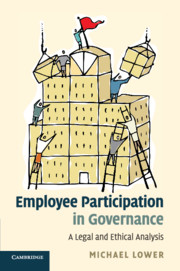Book contents
- Frontmatter
- Contents
- Acknowledgements
- Tables of legal instruments
- 1 Introduction
- 2 Catholic Social Thought: nature, sources and core principles and values
- 3 Catholic Social Thought and work
- 4 Catholic Social Thought, private property and markets
- 5 The corporation
- 6 The firm and society
- 7 Employee participation in corporate governance: an ethical analysis
- 8 Corporate Governance in the United Kingdom
- 9 Labour law and employee participation
- 10 Employee participation and EU corporate governance
- 11 Conclusion
- Bibliography
- Index
3 - Catholic Social Thought and work
Published online by Cambridge University Press: 05 October 2010
- Frontmatter
- Contents
- Acknowledgements
- Tables of legal instruments
- 1 Introduction
- 2 Catholic Social Thought: nature, sources and core principles and values
- 3 Catholic Social Thought and work
- 4 Catholic Social Thought, private property and markets
- 5 The corporation
- 6 The firm and society
- 7 Employee participation in corporate governance: an ethical analysis
- 8 Corporate Governance in the United Kingdom
- 9 Labour law and employee participation
- 10 Employee participation and EU corporate governance
- 11 Conclusion
- Bibliography
- Index
Summary
Introduction
CST is committed to employee participation because it is convinced that work is a basic good for the human person. Work builds up the human personality and human communities. Work can only play its proper part, however, if it is carried out under properly human conditions; CST has made it its business to explain what these conditions are. At their most basic, they aim to prevent outright exploitation of the worker. But that is not all there is to it. The relationship between the worker, the tools of his or her work and the ‘object’ worked upon has to be properly structured to ensure that the worker is the active subject of the work process. Otherwise, the worker is, more or less, reduced to the status of a cog in a machine and is alienated from his or her work. CST's calls for employee participation are its attempt to explain the principles for a well-ordered relationship between the worker and the work process. CST looks at work (and the institutions that surround it) through the prism of the integral self-realisation of each and every worker.
Laborem exercens deals with the question of employee rights; the worker has rights corresponding to his duty to work; the right to access to employment opportunities, to a fair wage, reasonable rest and the right to join a trade union.
- Type
- Chapter
- Information
- Employee Participation in GovernanceA Legal and Ethical Analysis, pp. 40 - 49Publisher: Cambridge University PressPrint publication year: 2010

